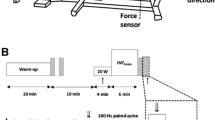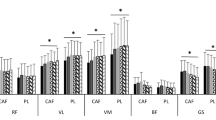Abstract
The aim of this investigation was to test the hypothesis that the anaerobic peak power output (P an, peak) declines more than the peak aerobic power (P aer, peak) with increasing age. In addition, the force-velocity (F-ν) relationship was studied to determine which of these two factors is primarily responsible for the expected alterations in anaerobic power. TheP an, peak, the maximalF when ν is equal to zero (F 0) and the maximal ν whenF is equal to zero (ν0) were assessed byF-ν test i.e. a brief intense intermittent exercise test using incremental braking forces. TheP aer, peak was measured by a maximal increment exercise test. A group of 12 young athletes (YA) and 12 master athletes (MA) mean age 24.8 (SEM 1.3) and 65.1 (SEM 1.2) years, respectively, participated in this study. The YA and MA had similar body masses, heights and endurance training schedules. The results showed thatP an, peak was 42.7% lower in the older subjects, corresponding to mean values of 1089 (SEM 40) compared to 624 (SEM 33) W (t = 8.9,P < 0.001) for YA compared to MA, respectively. TheF 0 andV 0 indices showed values that were lower by 30.3% and 15.2%, respectively. TheP aer, peak was 35 % lower with mean values of 323 (SEM 12) W for YA compared to 210 (SEM 6) W for MA (t = 8.3,P < 0.001). The mean maximal oxygen uptake was 34.7% lower with 4240 (SEM 160) ml · min−1 for YA compared to 2770 (SEM 120) ml · min−1 for MA(t = 7.2,P < 0.001).TheP an, peak:P aer, peak ratio and ν0/F 0coefficient were 12.1% lower and 18.4% higher, respectively. In summary, this study showed that in endurance-trained athletes, the age-related difference inP an, peak was significantly greater than that ofP aer, peak. Similarly, the age-related difference inF was significantly greater than that in ν.
Similar content being viewed by others
References
Barnard RJ, Garden GW, Diaco NV, MacAlpin RN, Kattus AA (1973) Cardiovascular responses to sudden strenuous exercise - heart rate, blood pressure and ECG. J Appl Physiol 34:833–837
Bedu M, Fellmann N, Spielvogel H, Falgairette G, Van Praagh E, Coudert J (1991) Force-velocity and 30 s Wingate tests in boys at high altitudes. J Appl Physiol 70:1031–1037
Brooks S, Faulkner JA (1994) Skeletal muscle weakness in old age: underlying mechanisms. Med Sci Sports Exerc 26:432–439
Buchner DM, de Lateur BJ (1991) The importance of skeletal muscle strength to physical function in older adults. Ann Behav Med 13:91–98
Carlson BM (1992) Muscle regeneration and aging. Monogr Dev Biol 23:189–195
Chick TW, Cagle TG, Vegas FA, Poliner JK, Murata GH (1991) The effect of aging on submaximal exercise performance and recovery. J Gerontol Biol Sci 46:B34–38
Delgado A, Allemandou A, Póres G (1993) Changes in characteristics of anaerobic exercise in the upper limb during puberty in boys. Eur J App Physiol 66:376–380
Doherty TJ, Vandervoort AA, Taylor AW, Brown WF (1993) Effects of motor unit losses on strength in older men and women. J Appl Physiol 74:868–874
Ferretti G, Narici MV, Binzoni T, Gariod L, Le Bas JF, Reutenauer H, Cerretelli P (1994) Determinants of peak muscle power: effects of age and physical conditioning. Eur J Appl Physiol 68:111–115
Fleg JL, Lakatta EG (1988) Role of muscle loss in the age-associated reduction in\(\dot VO_{2\max } \). J Appl Physiol 65:1147–1151
Gaitanos GC, Williams C, Boobis H, Brooks S (1993) Human muscle metabolism during intermittent maximal exercise. J Appl Physiol 75:712–719
Grassi B, Cerretelli P, Narici MV, Marconi C (1991) Peak anaerobic power in master athletes. Eur J Appl Physiol 62:394–399
Heath GW, Hagberg JM, Ehsam AA, Holloszy JO (1981) A physiological comparison of young and older endurance athletes. J Appl Physiol Respir Environ Exerc Physiol 51:634–640
Jones NL, Makrides L, Hitchcock C, Chypchar T, McCartney N (1985) Normal standards for an incremental progressive cycle ergometer test. Am Rev Respir Dis 131:700–708
Lakomy HKA (1986) Measurement of work and power output using friction-loaded cycle ergometers. Ergonomics 29:509–517
Larsson L, Grimby G, Karlsson J (1979) Muscle strength and speed of movement in relation to age and muscle morphology. J Appl Physiol Respir Environ Exerc Physiol 46:451–456
Lasslett LJ, Rubin BJ, Bringhurst E, Amsterdam EA (1991) Predicitve value of a negative exercise electrocardiogram. Cardiology 79:280–283
Linossier MT, Denis C, Dormois D, Geyssant A, Lacour JR (1993) Ergometric and metabolic adaptation to a 5-s sprint training programme. Eur J Appl Physiol 67:408–414
Massé-Biron, J, Mercier J, Collomp K, Hardy JM, Prefaut C (1992) Age and training effects on the lactate kinetics of master athletes during maximal exercise. Eur J Appl Physiol 65:311–315
Mercier J, Mercier B, Prefaut C (1991) Blood lactate increase during the force-velocity exercise test. Int J Sports Med 12:17–20
Mercier B, Granier P, Mercier J, Trouquet J, Préfaut C (1993) Anaerobic and aerobic components during arm-crank exercise in sprint and middle-distance swimmers. Fur J Appl Physiol 66:461–466
Ogawa T, Spina RJ, Martin WH, Kohrt WM, Schechtman KB, Holloszy JO, Ehsani AA (1992) Effects of aging, sex, and physical training on cardiovascular responses to exercise. Circulation 86:494–503
Péres G, Vandewalle H, Monod H (1981) Aspect particulier de la relation charge-vitesse sur cycloergomètre. J Physiol (Paris) a:77(10A)
Pollock ML, Wilmore J (1990) Exercise in health and disease: evaluation and prescription for prevention and rehabilitation. Saunders, Philadelphia, pp 575–626
Poulin MJ, Paterson DH, Govinda-Samy D, Cunningham DA (1992) Endurance training of older men: responses to submaximal exercise. J Appl Physiol 73:452–457
Vandewalle H, Péres G, Heller J, Panel J, Monod H (1987) Forcevelocity relationship and maximal power on a cycle ergometer. Fur J Appl Physiol 56:650–656
Author information
Authors and Affiliations
Rights and permissions
About this article
Cite this article
Chamari, K., Ahmaidi, S., Fabre, C. et al. Anaerobic and aerobic peak power output and the force-velocity relationship in endurance-trained athletes: effects of aging. Europ. J. Appl. Physiol. 71, 230–234 (1995). https://doi.org/10.1007/BF00854983
Accepted:
Issue Date:
DOI: https://doi.org/10.1007/BF00854983




